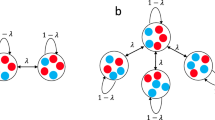Abstract
Evolutionary dynamics for the Moran process have been previously examined within the context of fixation behaviour for introduced mutants, where it was demonstrated that certain spatial structures act as amplifiers of selection. This article will revisit the assumptions for this spatial Moran process and show that proportional global fitness, introduced as part of the Moran process, is necessary for the amplification of selection to occur. Here it is shown that under the condition of local proportional fitness selection the amplification property no longer holds. In addition, regular structures are also shown to have a modified fixation probability from a panmictic population when local selection is applied. Theoretical results from population genetics, which suggest fixation probabilities are independent of geography, are discussed in relation to these local graph-based models and shown to have different assumptions and therefore not to be in conflict with the presented results. This paper examines the issue of fixation probability of an introduced advantageous allele in terms of spatial structure and various spatial parent selection models. The results describe the relationship between structured populations and individual selective advantage in a problem independent manner. This is of significant interest to the theory of fine-grained spatially-structured evolutionary algorithms since the interaction of selection and space for diversity maintenance, selection strength and convergence underlies resulting evolutionary trajectories.









Similar content being viewed by others
References
Lundy, I., Possingham, H.: Fixation probability of an allele in a subdivided population with asymmetrical migration. Genet. Res. Comb. 71, 237–245 (1998)
Wright, S.: Isolation by distance. Genetics 28, 114–138 (1943)
Wright, S.: Isolation by distance under diverse systems of mating. Genetics 31, 39–59 (1946)
Maruyama, T.: On the rate of decrease of heterozygosity in circular stepping stone models of populations. Theor. Pop. Biol. 1, 101–119 (1970)
Maruyama, T.: The rate of decrease of heterozygosity in a population occupying a circular or a linear habitat. Genetics 67, 437–454 (1971)
Maruyama, T.: A simple proof that certain quantities are independent of the geographical structure of population. Theor. Popul. Biol. 5, 148–154 (1974)
Slatkin, M.: Fixation probabilities and fixation times in a subdivided population. Evolution 35, 477–488 (1981)
Jong, K.D., Sarma, J.: On decentralizing selection algorithms. In: Proceedings of Sixth International Conference on Genetic Algorithms, Morgan Kaufmann Publishers, Inc, San Francisco, California, pp. 17–23 (1995)
Rudolph, G.: On takeover times in spatially structured populations: array and ring. In: Lai, K., Katai, O., Gen, M., Lin, B. (eds.) Proceedings of the Second Asia-Pacific Conference on Genetic Algorithms and Applications. Global-Link Publishing Company, Hong Kong, pp. 144–151 (2000)
Giacobini, M., Tomassini, M., Tettamanzi, A., Alba, E.: Selection intensity in cellular evolutionary algorithms for regular lattices. IEEE Trans. Evol. Comp. 9(5), 489–505 (2005)
Tomassini, M.: Spatially Structured Evolutionary Algorithms. Springer-Verlag, Berlin (2005)
Bryden, K., Ashlock, D., Corns, S., Willson, S.: Graph-based evolutionary algorithms. IEEE Trans. Evol. Comp. 10(5), 550–567 (2006)
Dick, G., Whigham, P.: The behaviour of genetic drift in a spatially-structured evolutionary algorithm. In: 2005 IEEE Congress on Evolutionary Computation, IEEE Press, 1855–1860 (2005)
Lieberman, E., Hauert, C., Nowak, M.A.: Evolutionary dyamics on graphs. Nature 433, 312–316 (2005)
Nowak, M., Sigmund, K.: Evolutionary dynamics of biological games. Science 303, 793–799 (2004)
Taylor, C., Iwasa, Y., Nowak, M.: A symmetry of fixation times in evolutionary dynamics. J. Theor. Biol. 243, 245–251 (2006)
Whigham, P., Dick, G.: Fixation of neutral alleles in spatially structured populations via genetic drift: describing the spatial structures of faster-than-panmictic configurations. In: Whigham, P. (ed.) Proceedings of the 17th Annual Colloquium of the Spatial Information Research Centre (SIRC). Otago University Press, Dunedin, New Zealand, pp. 81–90 (2005)
Whigham, P., Dick, G.: How does space alter the formulation of evolutionary models? In: Whigham P (ed.) Proceedings of the 18th Annual Colloquium of the Spatial Information Research Centre (SIRC). Otago University Press, Dunedin, New Zealand, pp. 79–83 (2006)
Komarova, N.: Spatial stochastic models for cancer initiation and progression. Bull. Math. Biol. 68, 1573–1599 (2006)
Whigham, P., Dick, G.: Evolutionary dynamics on graphs: The Moran process. In: Simulated Evolution and Learning, LNCS 4247, Springer, pp. 1–8 (2006)
Repsilber, D., Bialozyt, F.: Spatial genetic patterns systematically accelerate and bias drift-based genetic erosion. Ecol. Model. 148, 251–261 (2002)
Whitlock, M.: Fixation probability and time in subdivided populations. Genetics 164, 767–779 (2003)
Cherry, J.: Selection in a subdivided population with local extinction and recolonization. Genetics 164, 789–795 (2003)
Whigham, P., Green, D.: A spatially-explicit model of genetic tradeoff. In: Stonier, R., Qing-Long, H., Wei, L. (eds.) Proceedings of the 7th Asia-Pacific Complex Systems Conference, Cairns, Australia, pp. 91–100 (2004)
Author information
Authors and Affiliations
Corresponding author
Rights and permissions
About this article
Cite this article
Whigham, P.A., Dick, G. Evolutionary dynamics for the spatial Moran process. Genet Program Evolvable Mach 9, 157–170 (2008). https://doi.org/10.1007/s10710-007-9046-6
Received:
Revised:
Accepted:
Published:
Issue Date:
DOI: https://doi.org/10.1007/s10710-007-9046-6




